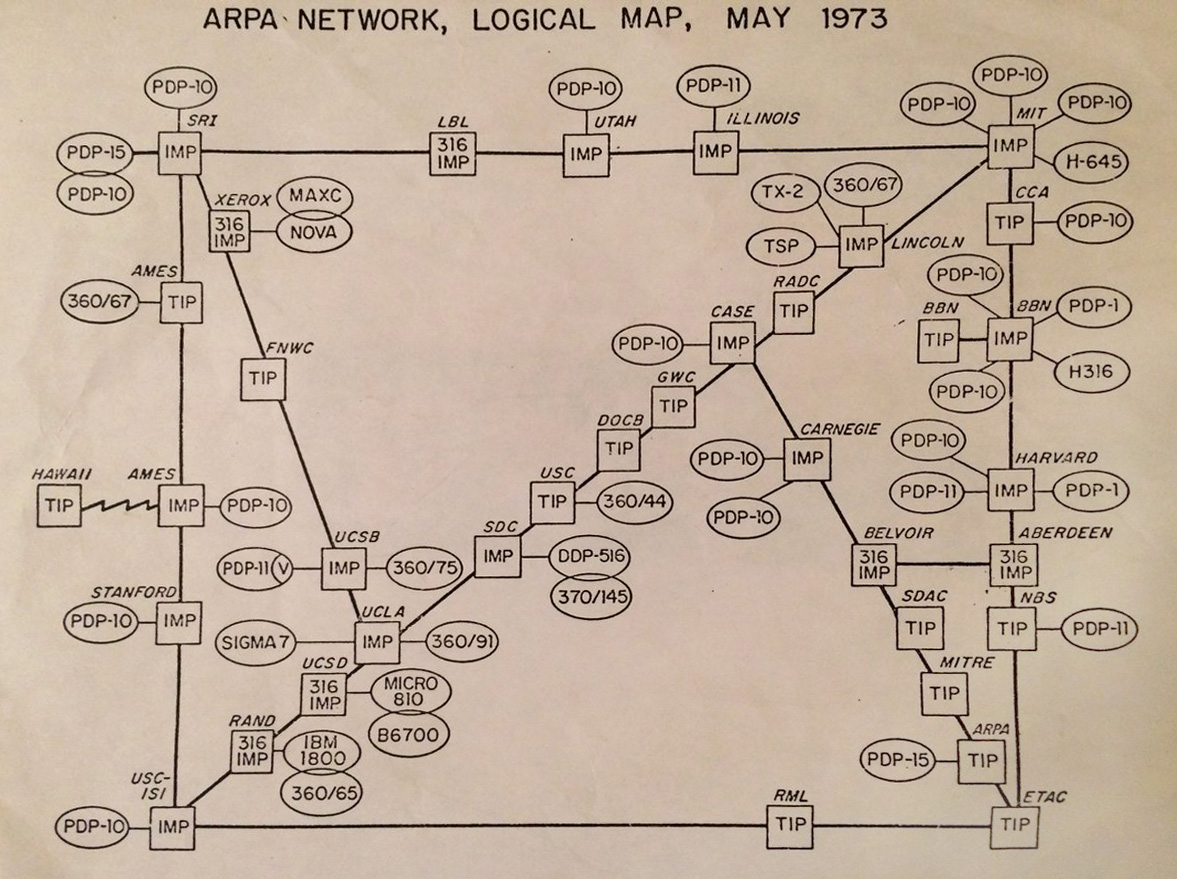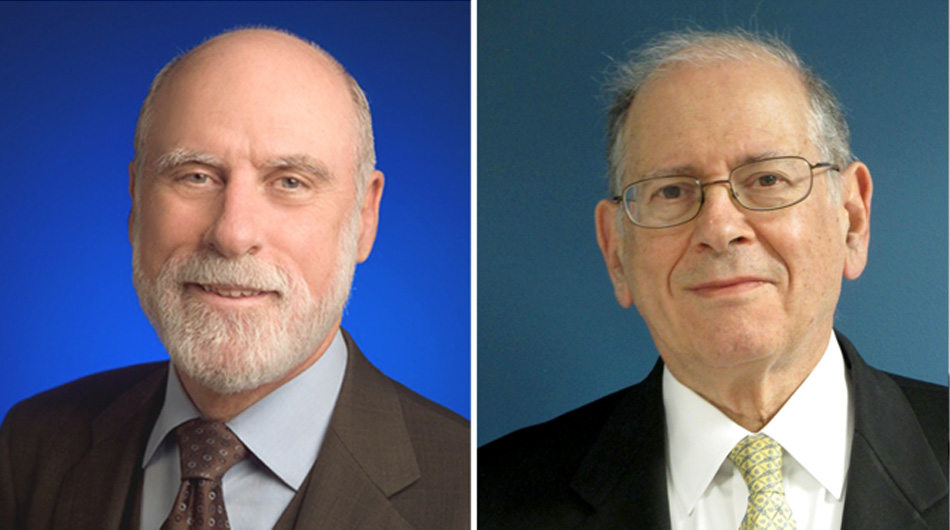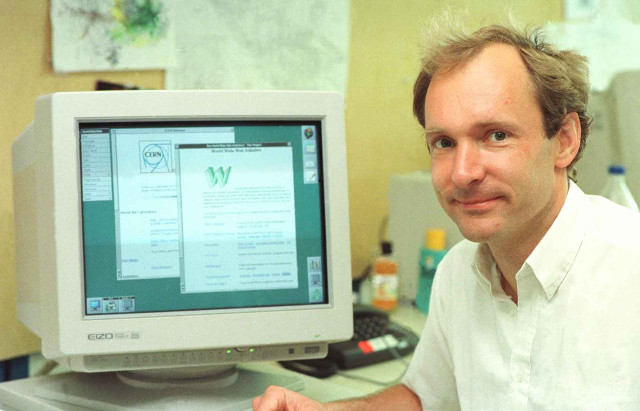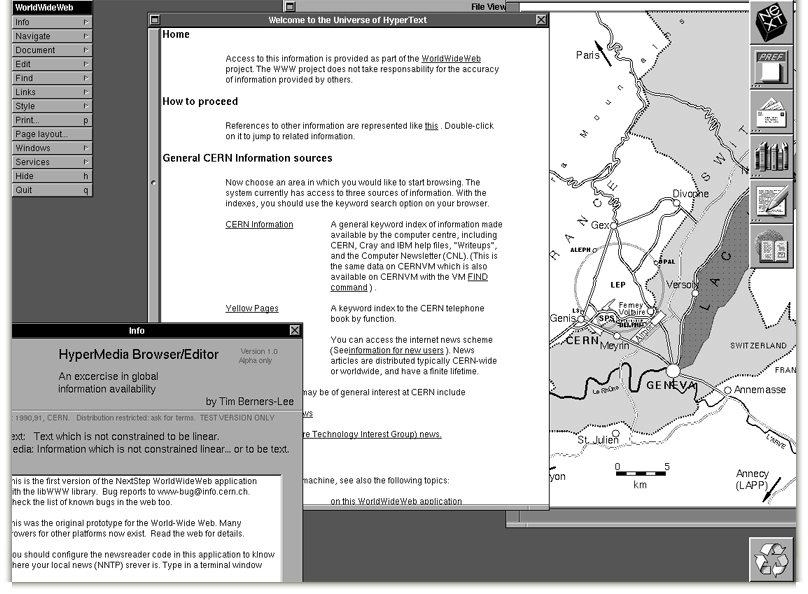
Logical map of ARPANET in 1973

Logical map of ARPANET in 1973
During the 70's, the number of computers connected to ARPANET continued to grow. The information on how to connect to each host of the network was maintained in a centralized text file, which was called HOSTS.TXT. Each computer connected to ARPANET first downloaded this text file. So that it knew how to connect to other computers on the network, looking for names and addresses. But as the number of hosts grew more and more, the method became impractical.
To replace the system of the single centralized text file, Paul Mockapetris and Jon Postel created the DNS in 1983. This system translates a name like facebook.com or google.com to an IP address such as 31.13.94.35. The DNS is still being used on the Internet today.

Paul Mockapetris and Jon Postel, creators of the DNS
DNS has many advantages, such as being decentralized and being prepared to grow together with the network. Each of the names used in the DNS system is called a domain. For example, wikipedia.org or youtube.com are domain names.
Until 1982 ARPANET used the NCP (Network Control Program) communication protocol . On the 1st of January of 1983 the change to the TCP/IP protocol took place. That is still the protocol being used in modern Internet. It was invented by Vint Cerf and Bob Kahn.
We could consider this change of protocol as the birth of the modern Internet, although in fact there were several gradual and cumulative changes that transformed the old ARPANET into the current Internet.

Vint Cerf and Bob Kahn, creators of the TCP/IP protocol
This communication protocol was so efficient that not only did it allow the Internet applications of that time ( e-mail and file transfer), but also the graphic World Wide Web, which was invented years later. And present-day services such as Netflix, Spotify or Whatsapp also work on top of that set of protocols. Most likely, any future Internet services and applications, will also work on top of TCP/IP.
In 1989, Tim Berners-Lee, a British scientist who was then working at the [CERN][11] in Switzerland, published a paper explaining that it would be convenient to create a system of hypertext that linked the scientific research documents and databases that were being used in CERN. This hypertext system should work regardless of the physical location, brand and operating system of the computers that held those documents.
 Tim Berners-Lee, creator of the World Wide Web
Tim Berners-Lee, creator of the World Wide Web
[11]: https://es.wikipedia.org/wiki/Organizaci% C3% B3nEuropeanfortheInvestigaci% C3% B3n_Nuclear The concept of hypertext (documents that in turn link to other documents automatically) was already known, but it had not been applied in a distributed and networked environment, until then. Berners-Lee waited for someone else to implement these ideas he had written in his paper. After two years, seeing that no one else was working on that project, he decided to do it himself. So, in 1991 he created the markup language HTML, the file transfer protocol HTTP and programmed the first web browser and the first web page server, using a Next machine. The most popular Internet application was born: the World Wide Web.

The original web browser, running on the NeXT machine
The first web browser ran only on the NeXT machine, and it was used to test the concept. Later, other web browsers appeared, and those could be executed on top of other operating systems and machines. Some of the pioneers were Mosaic (1993), followed by Netscape (1994) and Internet Explorer (1995).
With the arrival of the Windows 95 operating system , which included the Internet Explorer web browser, the use of the Web and the Internet finally became massive. Regular, home-based computer users discovered the Internet, as opposed to scientists and researchers, who had been the majority of the users until then.
In the second half of the '90s and the beginning of the 2000s, the large web-based Internet companies appeared. To name a few, Yahoo (1995), Hotmail (1996), Google (1997), LinkedIn (2003), Facebook (2004) and YouTube (2005). Virtually all of these companies have multimillion-dollar market valuations today, and hundreds of millions of users around the world.
The Internet and the Web have tremendously transformed our society in the last 50 years. It is estimated that currently 99% of global information is already generated and stored in digital format, and less than 1% on paper. Moreover, the information available on the Internet today is larger than all the information created by mankind from the beginning of the civilization until the late 20th century.
(C) August 1, 2018, Alejandro Moliné.
Your comments or feedback are welcome: contacto@alemoline.com